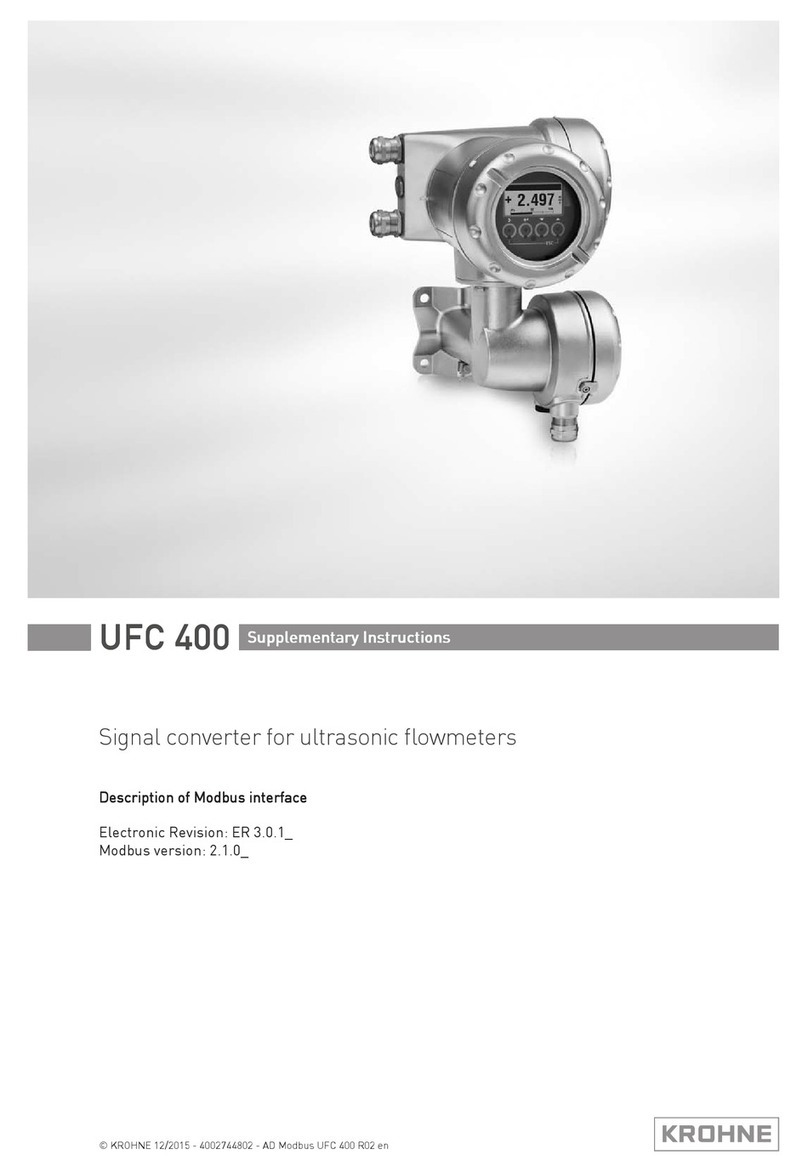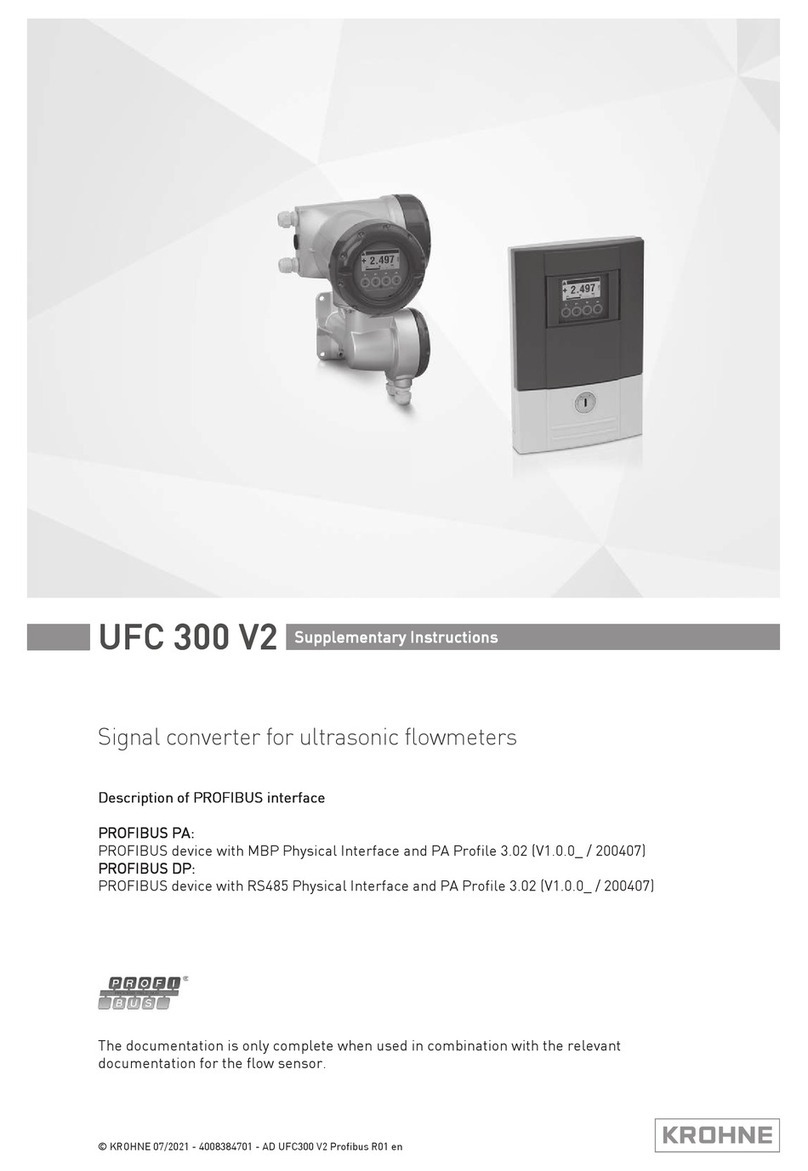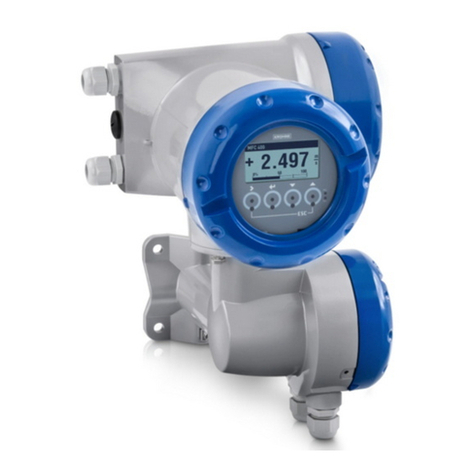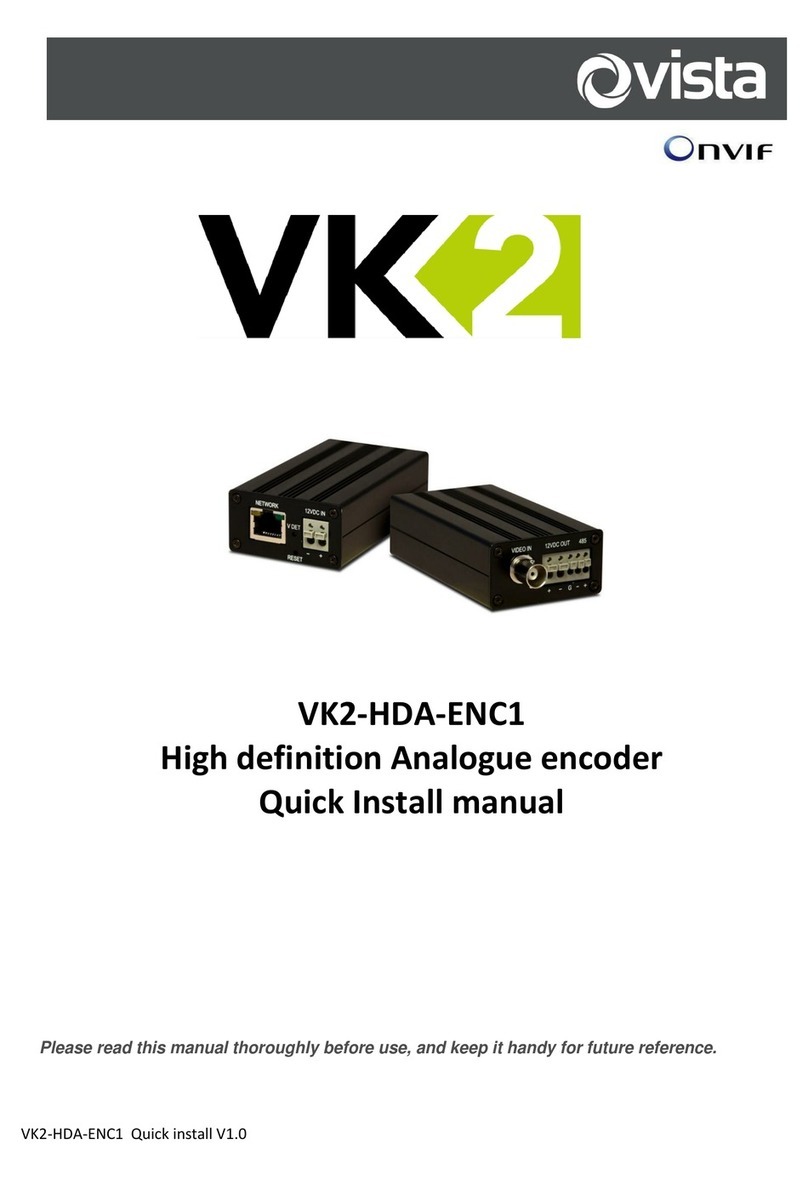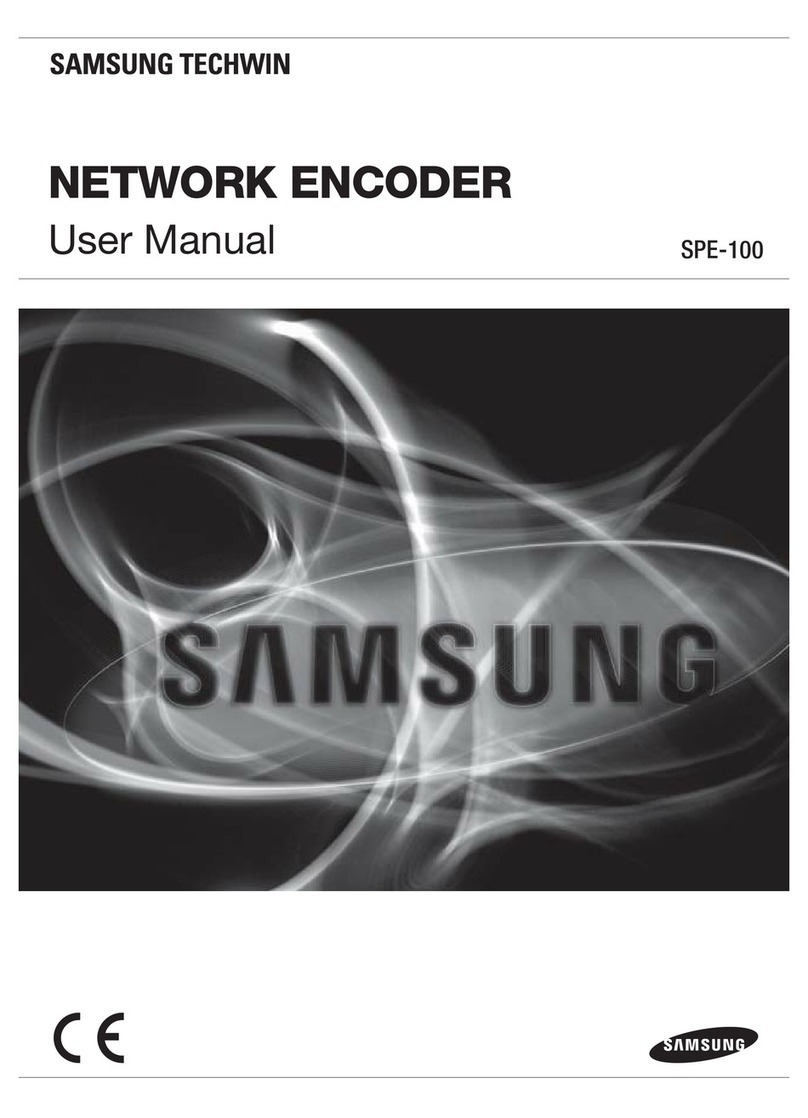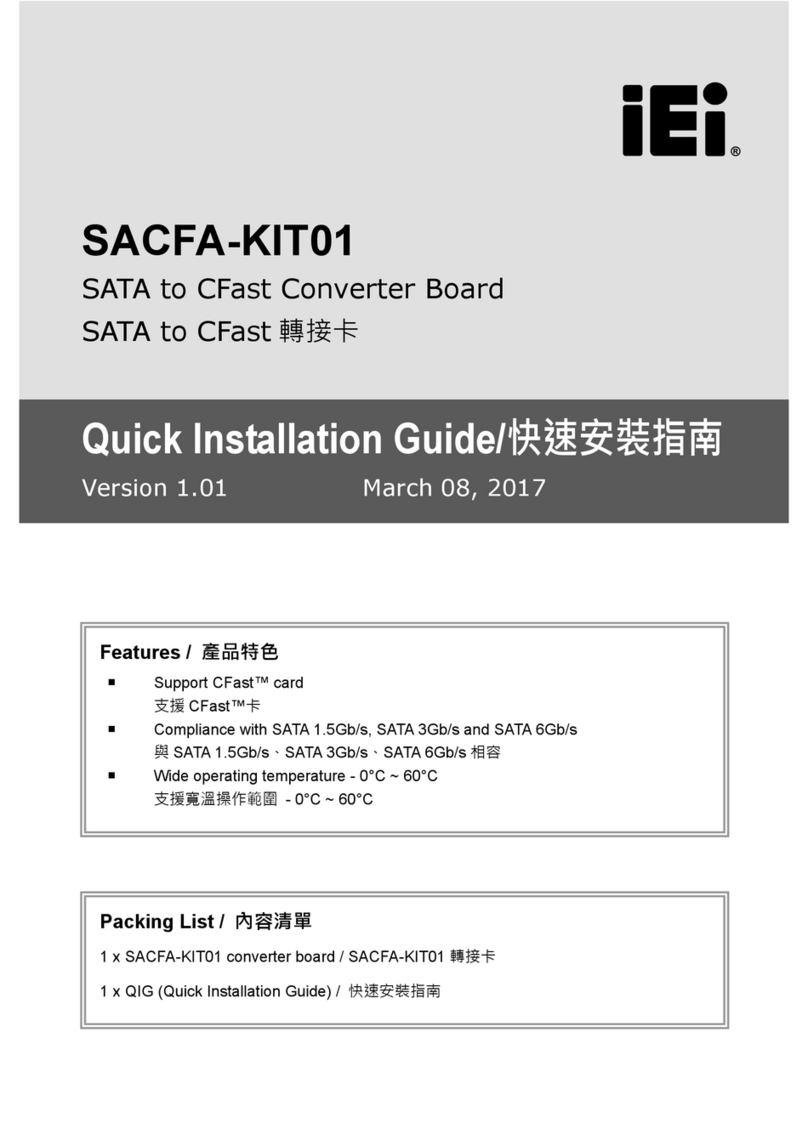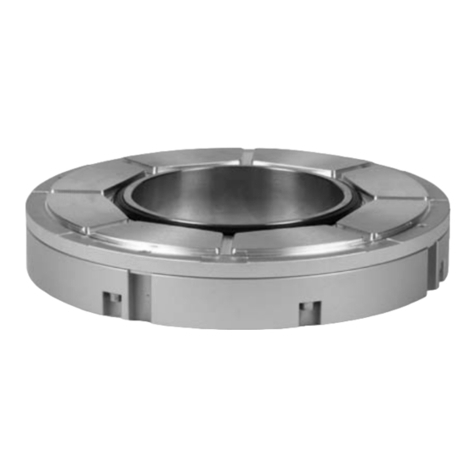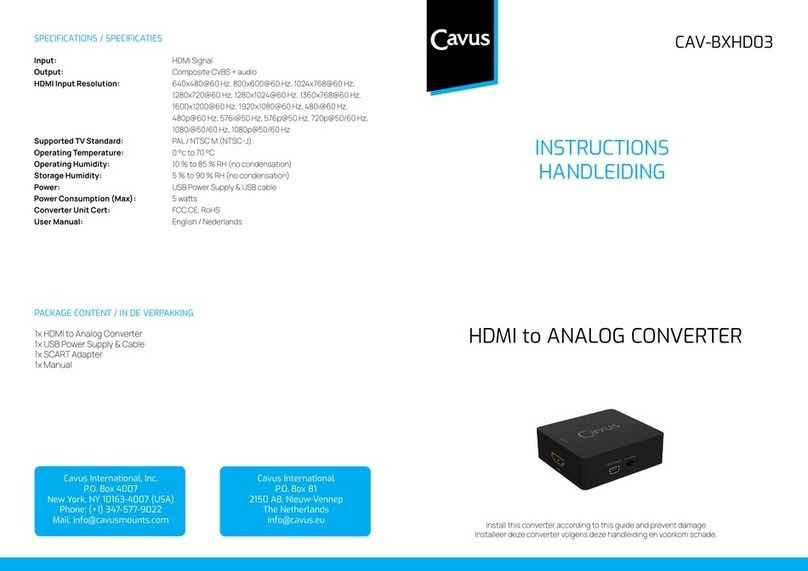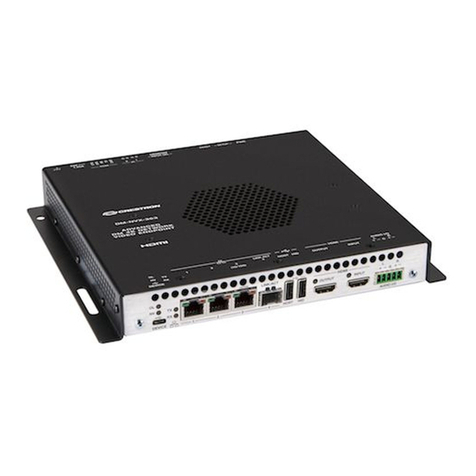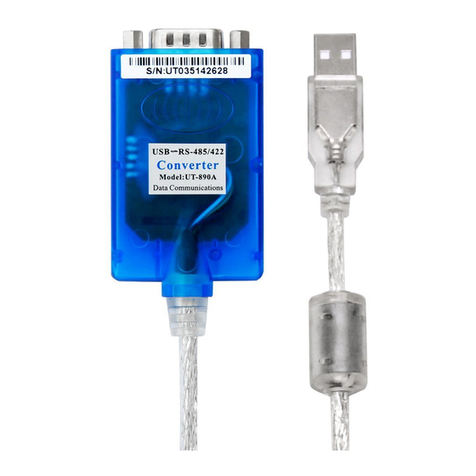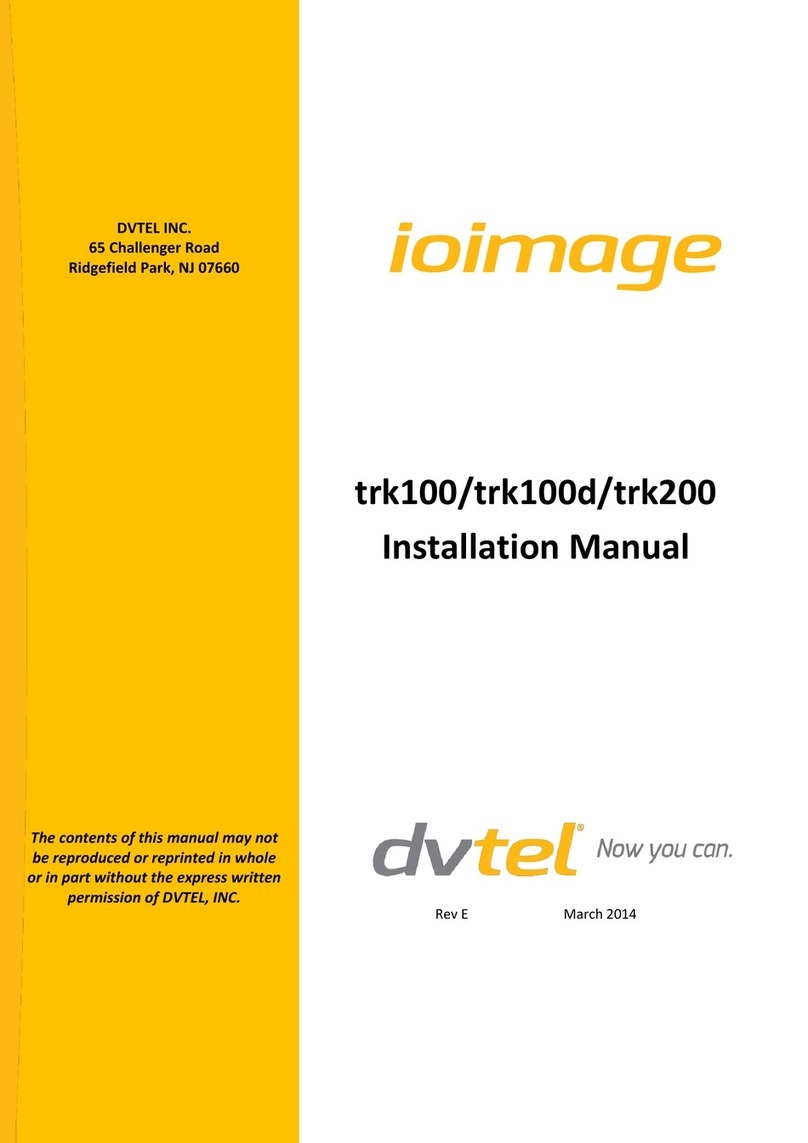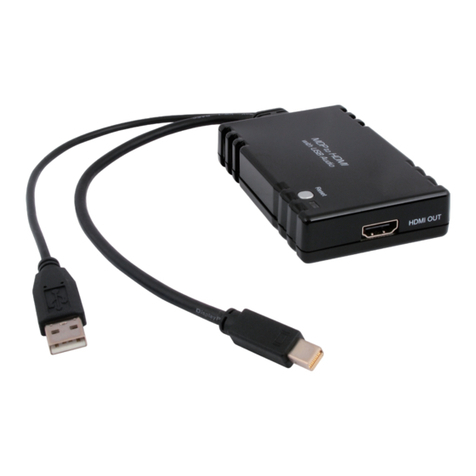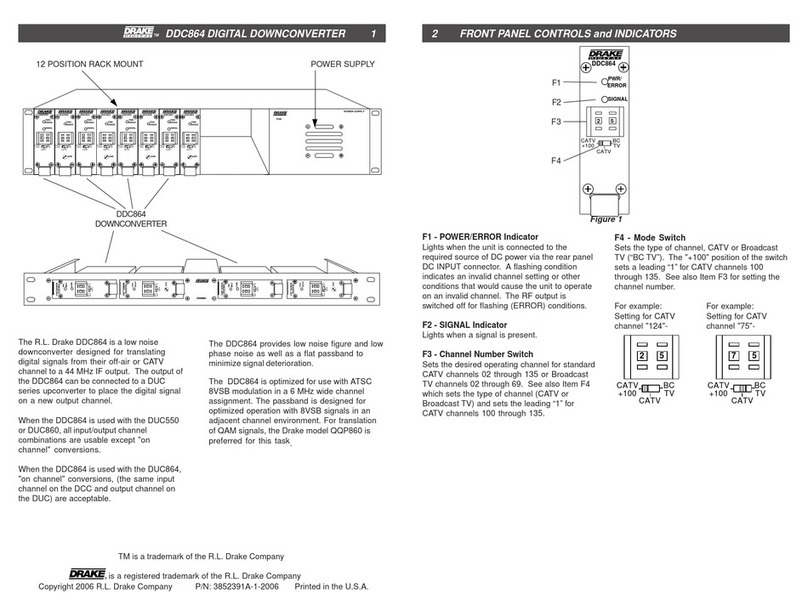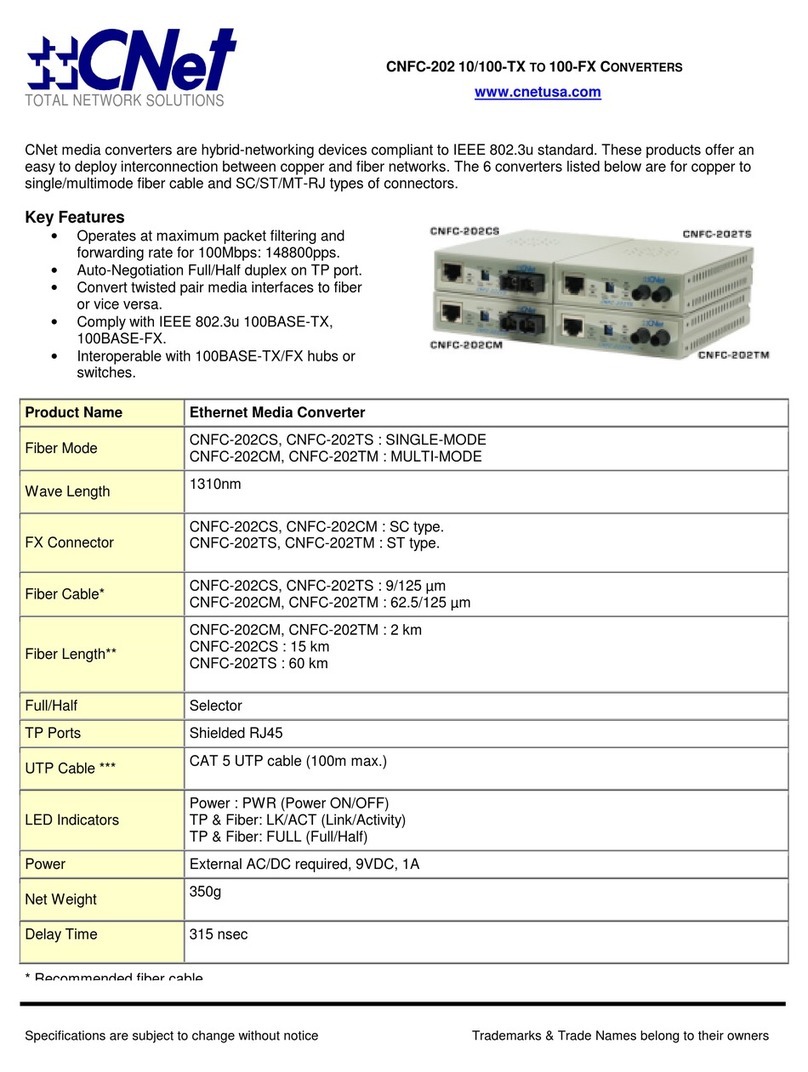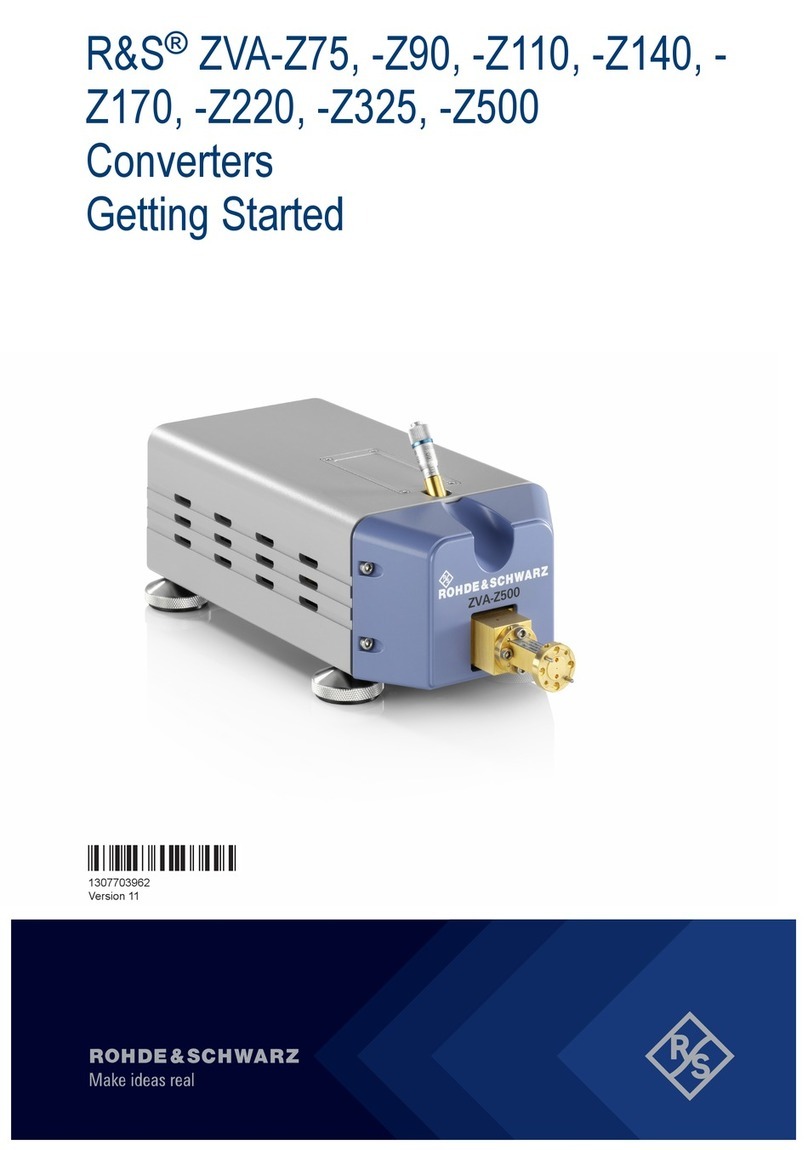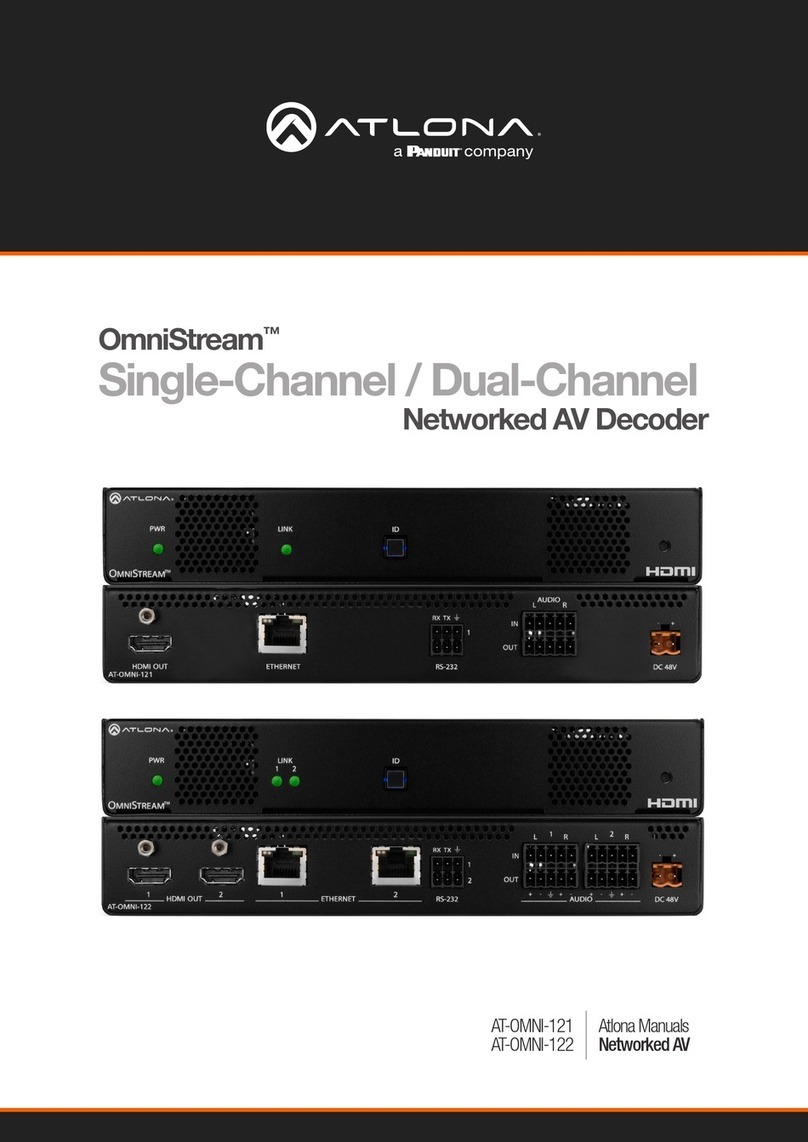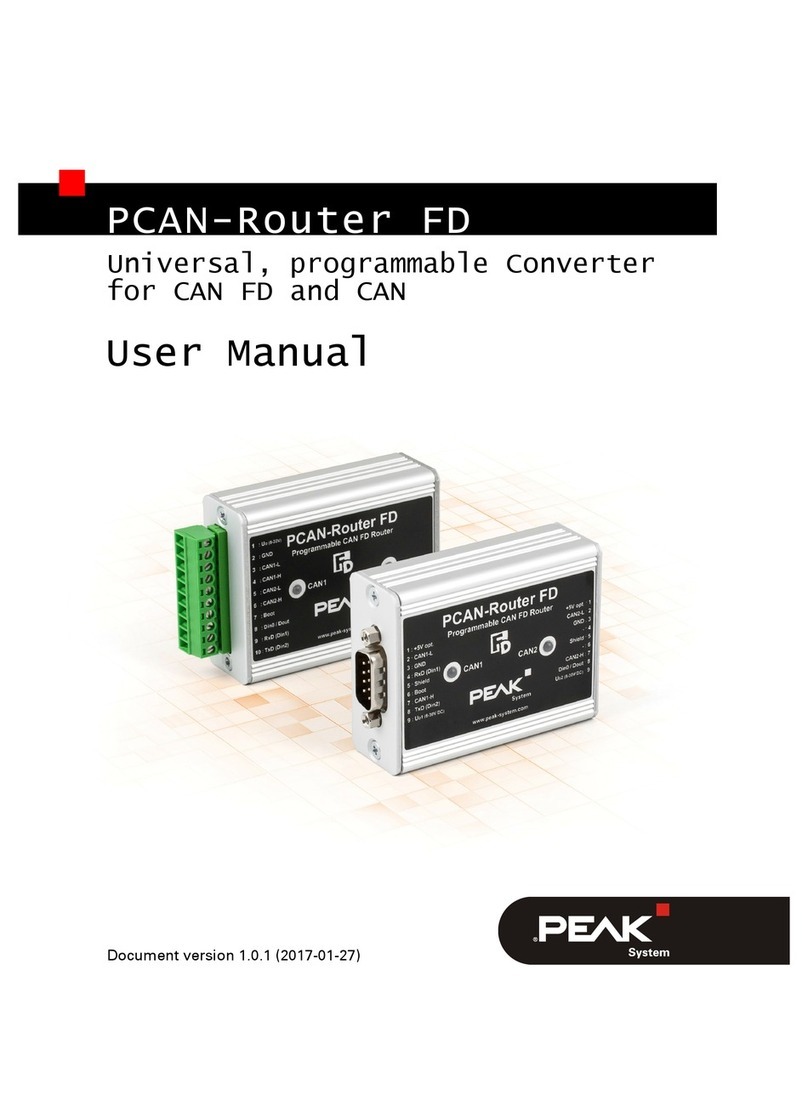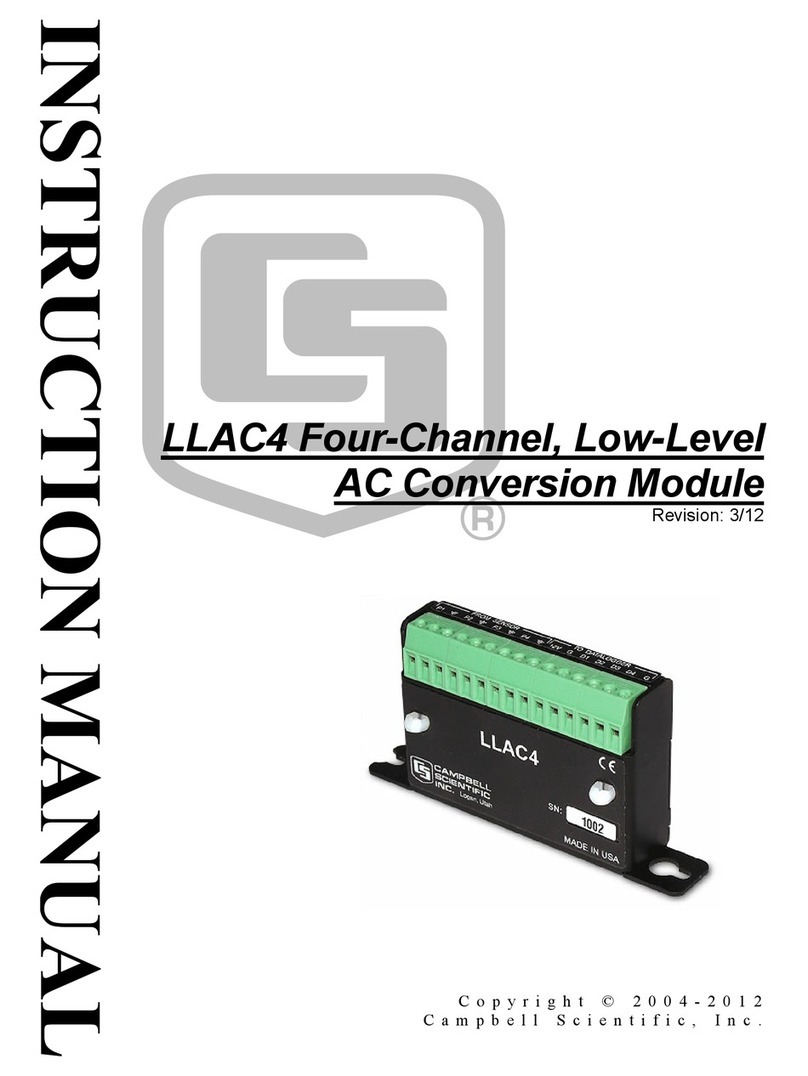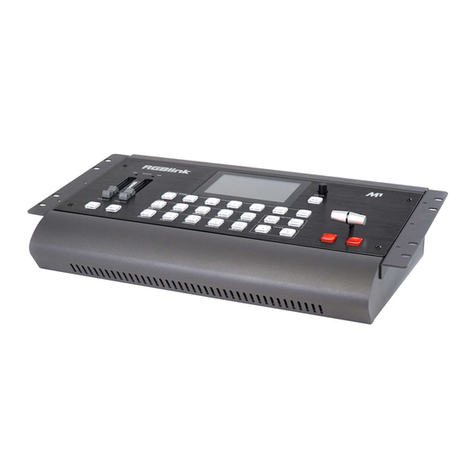KROHNE ifc 300 User manual


2IFC 300 03 / 2005
Contents
• CE / EMC / Standards / Approvals 3
• Safety information 4
• System description 4
• Product liability and warranty 4
• Items included with supply 5
• Signal converter versions and device nameplates 5
1 Electrical connection: power supply 6 - 15
1.1 Location and important notes on installation PLEASE NOTE ! 6 - 7
1.2 Connection to power for IFC 300 versions C, F and W 8
1.3 Electrical connection of remote sensors (primary heads) 9 - 15
1.3.1 General information on signal cables A and B, and field current cable C 9
1.3.2 Stripping (preparation) of signal cables A and B 10
1.3.3 Type, length and preparation of field current cable C 11
1.3.4 Grounding of sensors (primary heads) 12
1.3.5 Length of signal cable
max. distance between signal converter and sensor (primary head) 13
1.3.6 Connection diagrams (I and II) for power supply and sensors 14 - 15
2 Electrical connection: outputs and inputs 16 - 28
2.1 Important information on outputs and inputs PLEASE NOTE ! 16
2.2 I / O assemblies 16-18
2.3 Current output 19
2.4 Pulse and frequency output 20
2.5 Status output and limit switches 21
2.6 Control input 22 - 23
2.7 Connection diagrams (1 - 17) for inputs and outputs 24 - 28
3 Start-up 29

03 / 2005 IFC 300 3
4 Operator control of the signal converter 30 - 51
4.1 Display, operating and control elements 30
4.2 Function of the keys 31
4.3 KROHNE program structure for EMFs 32
4.4 Tables of settable functions 33 - 43
4.5 To reset counters 44
4.6 To delete error messages 44
4.7 General directions for special measurements, tasks and diagnostics 45
4.8 Special measurements 46
4.9 Special measurement tasks and diagnostics 46 - 47
4.10 Status messages and diagnostic information 48 - 51
5 Technical data 52 - 59
5.1 IFC 300 signal converter 52 - 55
5.2 Selection table for KROHNE sensors (primary heads) 56
5.3 Flow table 56
5.4 Measuring accuracy / error limits 57
5.5 Dimensions and weights 58
• If you need to return flowmeters to KROHNE for testing or repair 59
• Form to accompany a returned device (can be copied) 59
CE / EMC / Standards / Approvals
The electromagnetic flowmeters from KROHNE described in this handbook meet
the following safety requirements:
•EMC Directive 89 / 336 / EEC and 93 / 68 / EEC
in conjunction with EN 61326-1 (1997) and A1 (1998), A2 (2001)
• Low-Voltage Directives 73 / 23 / EEC and 93 / 68 / EEC
in conjunction with EN 61010-1: 2001
• Pressure Equipment Directive 97 / 23 / EC
• Ex Directive 94 / 9 / EC (ATEX 100a) for versions designed for use in
hazardous areas
• All devices bear the CE marking and meet the requirements of
• NAMUR Guideline NE 21 / 04 with IFC 300 signal converter.

4IFC 300 03 / 2005
Safety information
Please read these operating instructions and observe applicable national standards, safety requirements and
accident prevention regulations.
Installation and operation of the measuring device may only be carried out by qualified personnel.
Warning sign:
electric shock
hazard
WARNING!
Electric shock is dangerous and can cause severe burns and critical injuries!
Separate
manuals
available for
hazardous-
duty
equipment!
CAUTION!
Special regulations apply to use of equipment in hazardous areas, and these must
be observed without fail in order to ensure safe operation in such areas. Wiring,
installation, operation and maintenance may only be carried out by qualified
personnel trained in explosion protection.
WARNING!
CAUTION!
WARNING!
Indicates activities or occurrences which, if ignored, can lead to serious personal
injury, hazardous situations, faulty operation or destruction of the device.
CAUTION!
Indicates activities or occurrences which, if ignored, can lead to personal injury and
faulty operation of the device.
Info Information and tips
System description
Electromagnetic flowmeters are precision instruments designed for linear flow measurement of liquid products.
The process liquids must be electrically conductive, ≥1 µS/cm (depending on the sensor);
for cold demineralized water: ≥20 µS/cm.
The full-scale range Q100% can be set as a function of the sensor meter size (primary head) in keeping with the
flow velocity between v = 0.3 – 12 m/s, see flow table in Sect. 5.3.
Product liability and warranty
Electromagnetic flowmeters from KROHNE are designed solely for measuring the flow rate and the
conductivity of electrically conductive process liquids.
Such flowmeters are also available for use in hazardous areas.
Special regulations apply in this case, which are given in the special EEx directions,
see separate operating instructions.
Responsibility as to suitability and intended use of these electromagnetic flowmeters rests solely with the
operator.
Improper installation and operation of the flowmeters (systems) may lead to loss of warranty.
In addition, the “General conditions of sale“ forming the basis of the purchase contract are applicable.
If flowmeters need to be returned to KROHNE, please note the information given on the last-but-one page of
these Instructions. KROHNE regret that they cannot repair or check your flowmeter(s) unless they are
accompanied by the completed form sheet.

03 / 2005 IFC 300 5
Items included with supply
•Signal converter in the version as ordered.
•Signal cable (only for remote versions F and W) in the version and length as ordered
(Standard: signal cable A, length 5 m)
•Report on factory settings
•Calibration report
•Quick Start directions, in the language ordered, for installation, electrical connection, start-up and
operator control of the signal converter.
•CD-ROM with manuals for the sensors and the signal converter.
Signal converter versions and device nameplates
Your measuring device is delivered in ready-to-operate condition. Operating data have been factory-set to
your order. The signal converter is equipped as standard with a local display, operator control elements and
with a HART®interface
IFC 300 C Compact flowmeter,
signal converter mounted directly on the flow sensor
IFC 300 F Signal converter in field housing, remote version,
electrical connection to the flow sensor via field current and signal cables
IFC 300 W Signal converter in wall-mounted housing, remote version,
electrical connection to the flow sensor via field current and signal cables
IFC 300 R Signal converter in 19“ rack, remote version,
electrical connection to the flow sensor via field current and signal cables (in preparation)
C and F (option) These versions available for use in hazardous areas.
Please check against the device nameplates that the device supplied is in the correct version,
see following examples. The nameplate for inputs/outputs is illustrated in Sect. 2.2.
Examples for nameplates

6IFC 300 03 / 2005
1 Electrical connection: Power supply
1.1 Location and important notes on installation PLEASE NOTE !
•Electrical connection in conformity with VDE 0100 “Regulations for electrical power
installations with line voltages up to 1000 V“ or equivalent national regulations.
•Use separate entry fittings (PG screwed cable entries) for power supply, field current and
signal cables, and for outputs and inputs.
•Protect signal converter against direct solar radiation, install a sunshade if necessary.
•Signal converters installed in switchgear cabinets require adequate cooling, e.g. by fan or
heat exchanger.
•Do not expose signal converters to intense vibration.
KROHNE OPTIFLUX are tested at vibrational level to IEC 68-2-34:
broadband vibration test: f1= 20 Hz / f2= 2000 Hz / t = 90 min. / Test in all three axes (directions),
spectral acceleration density ASD = 0.01 g2/ Hz (aeff. = 4.5 g).
•Dimensions of the signal converter, see Sect. 5.5.
For separate systems / remote signal converters only (F and W versions)
•Mounting of the remote signal converter
•Mounting of the IFC 300 W:
Remove mounting plate from rear of signal converter, and attach to wall or standpipe. Replace
signal converter. Position lock washers and nuts on the housing bolts, tighten nuts slightly.
Align housing, tighten nuts firmly.
Dimensions, further information (minimum distances between signal converters):
see Sect. 5.5, Dimensions and weights
•Mounting the IFC 300 F:
Mount IFC 300 F with mounting plate on wall or standpipe.
Dimensions, further information (minimum distances between signal converters):
see Sect. 5.5, Dimensions and weights
•Keep distance between flow sensor and signal converter as short as possible, observe
max. allowed length of signal and field current cables, see Sect. 1.3.3 and 1.3.5.
•Use the supplied KROHNE signal cable A (type DS 300, standard) or B (type BTS 300,
bootstrap, optional), standard length 5 m / 15 ft.
•Generally use bootstrap signal cables B (type BTS 300) for OPTIFLUX 5000 F and OPTIFLUX
6000 F flow sensors, meter sizes DN 2.5 - 15 and 1/10” – 1/2”, and for contaminated liquids
which tend to form electrically insulating deposits.
•Always calibrate flow sensor and signal converter together! Also install together and make
sure settings of the primary constant GK / GKL are identical, see device nameplates and
report on settings for the signal converter.
If components are supplied separately, or in the case of a “mixed“ installation, the signal
converter must be set to the DN size and GK / GKL of the sensor; see Sect. 4.

03 / 2005 IFC 300 7
•Construction of the various housing versions
IFC 300 C (compact) and
IFC 300 F (remote)
The terminal compartments are accessible
after unscrewing cover 2
(and 5, for F Version only).
1 Cover, electronics compartment
2 Cover, terminal compartment for
power supply and inputs/outputs
3 Cable entry for power
4 Cable entry for inputs/outputs
for F Version only (remote)
5 Cover, sensor terminal compartment
6 Cable entry for field current cable
7 Cable entry for signal cable
8 Attachment plate for wall or pipe mounting
9 Locking screw for cover of
sensor terminal compartment(5)
The display of the IFC 300 C and IFC 300 F can be turned in steps of 90°.
To do this, unscrew the cover of the electronics compartment and remove the two metal clips to the left and
right of the display using a screwdriver or similar tool. The display between the metal clips can then be pulled off
and re-inserted in the required position. Before pushing the clips together with the display into the electronics
compartment, make sure not to kink the display´s flat ribbon cable more than absolutely necessary. Replace
cover and tighten down by hand.
Cover threads to be protected from dirt and well greased at all times;
particularly important for hazardous-duty (Ex) versions!
IFC 300 W (remote)
1 Cover, electronics compartment
2 Cover for the three separate terminal
compartments for power, sensor connection
and inputs/outputs
3 Locking screw, 1/2turn left/right
to open/close cover (2)
4 Safety lever to open cover (1)
5 Sensor terminal compartment,
open separate cover
6 Terminal compartment, outputs/inputs
7 Power terminal compartment,
open separate shock-hazard protection cover
8 Entry fitting for signal cable
9 Entry fitting for field current cable
10 Two cable entries for outputs/inputs
11 Cable entry for power supply
1
2
5
6 7
3
4
8
9
1
2
3
1
4
8 9 10 11
5 6 7

8IFC 300 03 / 2005
1.2 Connection to power for IFC 300 versions C, F and W
PLEASE NOTE !
•Degree of protection IP 65 and 67 to IEC 529 / EN 60529, equivalent to NEMA 4 / 4X and 6,
dependent on the version.
•Rated values: The housings of the flowmeters, which are designed to protect the electronic
equipment from dust and moisture, should be kept well closed at all times. Creepage
distances and clearances are dimensioned to VDE 0110 and IEC 664 for pollution severity 2.
Supply circuits are designed for overvoltage category III and the output circuits for overvoltage
category II.
•Fuse protection, disconnecting device: Fuse protection (IN≤16 A) for the infeed power
circuit, and also a disconnecting device (switch, circuit breaker) to isolate the signal converter
must be provided.
100-230 Volt AC (tolerance range -15% / +10%)
•Note the data on the nameplate, power supply voltage and frequency range (50 - 60 Hz).
•The protective ground conductor PE of the power supply must be connected to the
separate terminal in the terminal compartment of the signal converter.
•Connection diagrams I - II for the power supply and the electrical connection between flow
sensor (primary head) and signal converter: see Sect. 1.3.6.
12 - 24 Volt DC (tolerance range -25% / +30%)
•Note the data on the instrument nameplate!
•For reasons to do with the measurement process, connect a functional ground FE to the
separate U-clamp terminal in the terminal compartment of the signal converter.
•When connecting to functional extra-low voltages, provide a facility for protective separation
(PELV) (VDE 0100 / VDE 0106 and/or IEC 364 / IEC 536 or relevant national regulations).
•Connection diagrams I - II for the power supply and the electrical connection between flow
sensor and signal converter: see Sect. 1.3.6.
Connection to power (applies to all versions / housing versions)
Power consumption
• for AC = 22 VA
• for DC = 12 W
PE NL
AC: 100 - 230 V (-15% / +10%)
DC: 12 - 24 V (-25% / +30%) FE
L- L+
The power terminals in the terminal compartments are protected by additional
hinged lids against accidental contact.
Warning: Signal converter must be properly grounded to avoid personnel
shock hazard. All directions, operating data and connection diagrams do not apply to
devices used in hazardous areas; in such cases, read the special “Ex“ operating
instructions without fail!

03 / 2005 IFC 300 9
1.3 Electrical connection of remote sensors (primary heads)
1.3.1 General information on signal cables A and B and field current cable C
Proper functioning is ensured by the KROHNE signal cables A and B with double or
triple foil shielding.
However, when other signal cables are used, please note the following electrical data!
Electrical safety to EN 60811
(low-voltage directives)
or equivalent national standards.
Capacitance of signal wire
wire / wire < 50 pF/m or 15 pF/ft
wire / shield < 150 pF/m or 45 pF/ft
Isolation resisance >100 GΩ × km or >60 GΩ × mile
Voltage rating < 24 V / Current rating < 100 mA
Test voltage
Signal wire / inner shield 500 V
Signal wire / signal wire 1000 V
Signal wire / outer shield 1000 V
Twisting of signal wires
minimum 10× per meter or 3× per feet,
important when screening magnetic fields
•Lay signal cables as a fixed installation, underwater and underground laying possible.
•Connection of shields: - inner (1) via drain wire to normal connecting terminal
- outer (60) via braid to U-clamp terminal
•Insulating material is flame-retardant to EN 50625-2-1,IEC 60322-1.
•The low-halogen, unplasticized signal cables remain flexible at low temperatures.
Signal cable A (type DS 300), with double shielding
1Stranded drain wire, inner shield,
1.0 mm² Cu / AWG 17 (not insulated, bare)
10 Inner shield (see stranded drain wire 1)
2Insulated conductor, 0.5 mm² / AWG 20 (marking = 2)
3Insulated conductor, 0.5 mm² / AWG 20 (marking = 3)
6Stranded drain wire, outer shield,
0.5 mm² Cu / AWG 20 (not insulated, bare)
60 Outer shield (see stranded drain wire 6)
Outer sheath, dia. approx. 8 mm / 0.3” (marking = DS 300)
Signal cable B (type BTS 300) with triple shielding (bootstrap line)
1Stranded drain wire, inner shield,
1.0 mm² Cu / AWG 17 (not insulated, bare)
10 Inner shield (see stranded drain wire 1)
2Insulated conductor, 0.5 mm² / AWG 20 (marking = 2)
20 Stranded drain wire for individual shield of conductor 2
3Insulated conductor, 0.5 mm² / AWG 20 (marking = 3)
30 Stranded drain wire for individual shield of conductor 3
6Stranded drain wire, outer shield,
0.5 mm² Cu / AWG 20 (not insulated, bare)
60 Outer shield (see stranded drain wire 6)
Outer sheath, dia. approx. 12 mm / 0.5“ (marking = BTS 300)
In the bootstrap method, the individual shields (20 and 30) are always controlled by the signal converter
to exactly the same voltage that is present at signal wires (2 and 3). Because for that reason there is no
voltage difference between the individual shields (20 and 30) and the signal wires (2 and 3), no current
flows via the line capacitances between 2 / 20 or 3 / 30. The line capacitance is apparently “zero“.
This allows greater cable lengths when the electrical conductivity of the process product is low.
Field current cable C
Cross-section dependent on required length of cable, see Table in Sect. 1.3.3.

10 IFC 300 03 / 2005
1.3.2 Stripping (preparation) of signal cables A and B
Customer-supplied materials
W Insulation tubing (PVC),
dia. 2.0-2.5 mm / approx. 0.1”
X Heat-shrinkable tubing or cable sleeve
Y Wire end ferrule to DIN 41 228: E 1.5-8
Please note:
• The figures in tables and drawings
identify the shields,
stranded drain wires and wires of signal
cables A and B, see Sect. 1.3.1.
• The following tables and drawings indicate
the dimensions (a - d) for stripping the
signal cables.
Z Wire end ferrule to DIN 41 228: E 0.5-8
Signal cable A ( Typ DS 300) Signal cable B (Typ BTS 300)
approx. Length in mm / inch approx. Length in mm / inch
Signal converter Signal converter
dimen-
sion
Sensor
IFC 300 FIFC 300 W
dimen-
sion
Sensor
IFC 300 FIFC 300 W
a 60 / 2.4“ 90 / 3.5“ 90 / 3.5“ a 60 / 2.4“ 90 / 3.5“ 90 / 3.5“
b 10 / 0.4“ 10 / 0.4“ 10 / 0.4“ b 10 / 0.4“ 10 / 0.4“ 10 / 0.4“
c 8 / 0.3“ 8 / 0.3“ 8 / 0.3“ c8 / 0.3“ 8 / 0.3“ 8 / 0.3“
d -
25 / 1.0“ 25 / 1.0“
60 connect connect do not
connect
60 connect connect do not
connect
20 / 30 do not
connect
connect only
in the IFC 300
Signal cable A (type DS 300), with double shielding
Signal cable B (type BTS 300), with triple shielding (bootstrap)
Signal cable B
bending radius
≥50 mm / ≥2.0”
b
a
d
c
W
X
X
Z
Y
Z
60
Z
W
30
1
2 3
20
W
Z
Signal cable
A
bending radius
≥50 mm / ≥2.0”
b
c
a
W
Z
Y
Z
2
1
3
60 (Slip shield over outer sheath
and connect up.)
(Slip shield over outer sheath
and connect up.)

03 / 2005 IFC 300 11
1.3.3 Type, length and preparation of the field current cable C
Length and cross-section, field current cable C
Length Cross-section AF(Cu)
0 – 150 m 0 - 500 ft 3 x 0.75 mm² Cu 3 x AWG 18
150 – 300 m 500 - 1000 ft 3 x 1.50 mm² Cu 3 x AWG 14
300 – 600 m 1000 - 2000 ft 3 x 2.50 mm² Cu 3 x AWG 12
Cu = copper cross-section
For the IFC 300 W the terminals are designed for the following cable cross-sections:
• flexible cable: ≤1.5 mm² / ≤AWG 14
• solid cable: ≤2.5 mm² / ≤AWG 12
Preparation
e
10 mm
0.4“
90 mm / 3.5“
Field current
cable C
bending radius
50 mm / 2“
Wire end ferrules,
Size and dimension e
dependent on dia. of cable
Only if using a shielded
field current cable: cut back, slip
shield over the outer sheath and
connect up only in the sensor
connection box.

12 IFC 300 03 / 2005
1.3.4 Grounding of sensors (primary heads)
•The sensor must be properly connected to ground.
•The grounding cable should not transmit any interference voltages.
•Do not use the grounding cable to connect more than one device to ground.
•In hazardous areas, grounding is used at the same time for equipotential bonding. Special
grounding instructions are contained in the “Ex-installation instructions“, which are only
supplied together with hazardous-duty equipment.
•The sensors are connected to ground by means of a functional grounding conductor FE.
•Special grounding instructions for the various sensors are contained in the separate
installation instructions for the sensors.
•These instructions also contain detailed descriptions on how to use grounding rings and how
to install the sensors (primary heads) in metal or plastic pipes or in pipes which are coated on
the inside.
Warning: The signal converter must be properly grounded to avoid personnel
shock hazard. All diections, operating data and connection diagrams do not apply to
devices used in hazardous areas; in such cases, read the special “Ex“ operating
instructions without fail.

03 / 2005 IFC 300 13
1.3.5 Length of signal cable
max. distance between signal converter and sensor (primary head)
Abbreviations and explanatory notes
for the following table, diagram and connection diagrams
A Signal cable A / type DS 300, double shielding, max. length: see diagram below
B Signal cable B / type BTS 300, triple shielding, max. length: see diagram below
C Field current cable, cross-section and length: see Sect. 1.3.3
σ Electrical conductivity of process liquid
Meter size Min. elec. - Curve for signal cable
conductivity A
Sensor
primary head
DN mm inches µS / cm DN mm
OPTIFLUX 1000 F 10 - 150 3/8- 6 5 A 1 B 2
OPTIFLUX 2000 F 25 - 150 1 - 6 20 A 1 B 3
200 - 2000 8 - 80 20 A 2 B 4
OPTIFLUX 4000 F 2.5 - 6 1/10 - 1/610 - B 1
10 150 3/8- 6 1 A 1 B 3
200 - 2000 8 - 80 1 A 2 B 4
OPTIFLUX 5000 F 2.5
1/10 10 - B 1
4 - 15 1/6- 1/25 - B 2
25 - 100 1 - 4 1 A 1 B 3
150 - 250 6 - 10 1 A 2 B 4
OPTIFLUX 6000 F 2.5 - 15 1/10 - 1/210 - B 1
25 - 150 1 - 6 1
A
1B3
Please note !
For process temperatures above 150°C, special cables and a through-box ZD
are required. Optionally available, incl. modified circuit diagrams.
electrical conductivity [µS/cm]
max. cabel len
g
th
[
m
]
3000
300
30
max. cabel len
g
th
[
ft
]

14 IFC 300 03 / 2005
1.3.6 Connection diagrams (I and II) for power supply and sensors
Important notes for connection diagrams PLEASE NOTE !
Warning: Signal converter must be properly grounded to avoid personnel shock hazard.
All directions, operating data and connection diagrams do not apply to
devices used in hazardous areas; in such cases, read the special “Ex“ operating
instructions without fail!
•The figures in brackets identify the shields, stranded drain wires and cores of signal
cables A + B, see sectional drawings of signal cables in Sect. 1.3.1.
•Electrical connection to VDE 0100 “Regulations governing heavy-current installations with
line voltages up to 1000 V“
•Power supply 12 - 24 V DC: Functional extra-low voltage with safety separation
(PELV) to VDE 0100/VDE 0106 and/or IEC 364/IEC 365,
or equivalent national regulations.
•Systems used in hazardous areas are subject to special regulations concerning electrical
connections (see separate manual).
•Terminal 4 / 40: assigned only when sensors have 4 electrodes (special version)
•PE = protective conductor FE = functional ground
I Signal cable A / Type DS 300
Sensor / primary head
*These two cable
terminals are not
provided in the housing
of the IFC 300 W,
therefore, do not connect
up the outer shield of
cables A and C!
Power consumption
• for AC = 22 VA
• for DC = 12 W

03 / 2005 IFC 300 15
For IFC 300 F !
• IFC 300 F has separate terminal compartments for power supply,
flow sensor and for outputs and inputs.
•Connect the two overall shields for signal cables A and B in the sensor outlet box and
in the signal converter-sensor terminal compartment:
inner shield (10) by way of the stranded drain wire (1), and
outer shield (60) by way of the braid.
• There should be no difference in potential between the sensor and the housing
of the signal converter!
For IFC 300 W !
•IFC 300 W has 1 cover for the separate terminal compartments for power supply, sensor and
for outputs and inputs. The power terminal compartment has an additional hinged flap for
shock-hazard protection.
•The outer overall shield (60) of signal cables A and B can only be connected up in the sensor
outlet box!
II Signal cable B / Type BTS 300
Sensor / primary head
*These two cable
terminals are not
provided in the housing
of the IFC 300 W,
therefore, do not
connect up the
outer shield of
cables B and C!
Power consumption
• for AC = 22 VA
• for DC = 12 W

16 IFC 300 03 / 2005
2 Electrical connection: outputs and inputs
2.1 Important information for outputs and inputs PLEASE NOTE !
•The output / input groups are galvanically separated from each other and from all other
input and output circuits.
•Active mode: The signal converter supplies the power for operation (activation) of
receiver instruments; observe max. operating data.
•Passive mode: Operation (activation) of receiver instruments requires an external power
supply (Uext); observe max. operating data.
•Connection diagrams of outputs and inputs are shown in Sect. 2.7.
•For operating data of outputs and inputs, refer to Sect. 2.7 and 5.1.
2.2 I / O assemblies for the outputs and inputs
IFC 300 is available with a choiceof output/input assemblies:
•The Basic I/O has one mA, one pulse and 2 status outputs. The pulse output can be set as a status
output, and one of the status outputs as a control input (see Basic I/O table).
•The Modular I/O can be equipped with different output modules, depending on the task (see
Modular I/O table).
•For hazardous areas, all I/O variants are available for the IFC 300 C (compact) and
IFC 300 F (remote) with terminal compartment in EEx - d (flameproof enclosure) or
EEx - e (increased safety) protection.
•The Bus - System I/O allows intrinsically safe and non-intrinsically safe bus interfaces in combination
with further modules (see Bus - System I/O table).
•The last 3 places of the CG No. indicate the assigned terminals,
see examples below.
•Abbreviations used are explained in the small table on the next but one page.
Examples of CG No. to identify the electronic module and the I/O variants:
CG30* _ _ 4_ _ (see sticker inside cover of terminal compt)
General type designation 2nd option module for terminal B
Power 1st option module for terminal A
Display version I/O version identified by this place
(here: Modular I/O), fixed assignment of terminals C+D
(according to the 1st place of the CG No.)
CG No. (examples)
CG 300 11 100 100-230 V AC &Standard Display / Basic I/O:
Iaor Ip& Sp/Cp& Sp& Pp/Sp
(see Tabele and Nameplate on the next page)
CG 300 11 7FK 100-230 V AC &Standard Display / Modular I/O:
Ia&Pn/Snand option module PN/SN& CN
(see Tables on the next but one page)
CG 300 81 4EB 24 V DC &Standard Display / Modular I/O:
Ia&Pa/Saand option module Pp/Sp& Ip
(see Tables on the next but one page)

03 / 2005 IFC 300 17
Fixed, unalterable I/Os (input/output versions)
Terminals
I/Os CG-No.
D- D C- C B- B A- A A+
Basic 1 0 0 Ip+ HART®
Standard
or
(
reverse term.
)
Pp/ Sp
(changeable) SpSp/ Cp
(changeable) Ia+ HART®
EEx - i 2 0 0
Option
PN/ SNNAMUR
(changeable) Ia+ HART®active
3 0 0
PN/ SNNAMUR
(changeable) Ip+ HART®passive
2 1 0
PN/ SNNAMUR
(changeable) Ia+ HART®active PN/ SN/ CNNAMUR
(changeable) Ia
3 1 0
PN/ SNNAMUR
(changeable) Ip+ HART®passive PN/ SN/ CNNAMUR
(changeable) Ia
2 2 0
PN/ SNNAMUR
(changeable) Ia+ HART®active PN/ SN/ CNNAMUR
(changeable) Ip
3 2 0
PN/ SNNAMUR
(changeable) Ip+ HART®passive PN/ SN/ CNNAMUR
(changeable) Ip
PA - Bus D 0 0 Term PA- Term PA+ Term PA- Term PA+
PROFIBUS FISCO Device FISCO Device
(EEx-i) D 1 0 Term PA- Term PA+ Term PA- Term PA+
Option
FISCO Device FISCO Device
PN/ SN/ CNNAMUR
(changeable) Ia
D 2 0 Term PA- Term PA+ Term PA- Term PA+
FISCO Device FISCO Device
PN/ SN/ CNNAMUR
(changeable) Ip
FF - Bus E 0 0 Term V/D- Terrm V/D+ Term V/D- Terrm V/D+
Foundation FISCO Device FISCO Device
Field-Bus E 1 0 Term V/D- Terrm V/D+ Term V/D- Terrm V/D+
(EEx-i)
FISCO Device FISCO Device
PN/ SN/ CNNAMUR
(changeable) Ia
Option E 2 0 Term V/D- Terrm V/D+ Term V/D- Terrm V/D+
FISCO Device FISCO Device
PN/ SN/ CNNAMUR
(changeable) Ip
Nameplate inputs/outputs
Example of CG No., here:
BASIC I/O

18 IFC 300 03 / 2005
Alterable I/Os (input/output versions)
• The grey boxes denote freely selectable option modules for terminals A and B.
• Terminal A+ functions only for the Basic I/O.
•For hazardous areas, all I/O variants for IFC 300 C and IFC 300 F are available with
terminal compartment in EEx - d (flameproof enclosure) or EEx - e (increased safety) protection.
Terminals
I/Os CG-No. D- D C- C B- B A- A A+
Modular 4 _ _
Option
Pa/ Sa
(changeable) Ia+ HART®active max. 2 option modules for
term. B + A: Iaor Pa/ Saor Ca
8 _ _
Pa/ Sa
(changeable) Ip+ HART®passive max. 2 option modules for
term. B + A: Ipor Pa/ Saor Ca
6 _ _
Pp/ Sp
(changeable) Ia+ HART®active
max. 2 option modules for
term. B + A:
Iaor Pp/ Spor Cp
B _ _
Pp/ Sp
(changeable) Ip+ HART®passve max. 2 option modules for
term. B + A: Ipor Pp/ Spor Cp
7 _ _
PN/ SNNAMUR
(changeable) Ia+ HART®active max. 2 option modules for
term. B + A: Iaor PN/ SNor CN
C _ _
PN/ SNNAMUR
(changeable) Ip+ HART®passve max. 2 option modules for
term. B + A: Ipor PN/ SNor CN
PA - Bus D
_
_
PROFIBUS
Option
Term
PA- Term PA+ Term
PA-
Term
PA+
max. 2 option modules for
term. B + A: Iaor Pa/ Saor Cp
FF - Bus E _ _
Foundation Field-Bus
Option
Term
V/D-
Terrm
V/D+
Term
V/D-
Terrm
V/D+
max. 2 option modules for
term. B + A: Iaor Pa/ Saor Cp
DP - Bus F _ 0
PROFIBUS
Option
RxD/TxD
N
RxD/TxD
P
RxD/TxD
N
Termin.
N
RxD/TxD
P
Termin.
P
max. 1 option
module for
term. A:
see table
below for
selection
Option modules
Abbreviation Description Ident
for CG No.
IaActive current output A
IpPassive current output B
Pa/ SaActive pulse, frequency, status output or limit switch C
Pp/ SpPassive pulse, frequency, status output or limit switch E
PN/ SNPulse, frequency, status output or limit switch to NAMUR F
CaActive control input G
CpPassive control input K
CNControl input to NAMUR H
- No module installed 8
- No further module possible 0

03 / 2005 IFC 300 19
2.3 Current output
• Depending on the version, the outputs and inputs to be connected passively or
actively and / or to NAMUR EN 60947-5-6! The tables in Sect. 2.2 show which
I/O version and which inputs and outputs are installed in your signal converter,
see also the sticker inside the cover of the terminal compartment.
•All current outputs are galvanically separated from each other and from all other circuits.
•Depending on the version, up to 3 current outputs in parallel can be built in, one always
with HART®communication (except for Foundation Fieldbus and PROFIBUS).
•Factory-set data and functions are given in the enclosed report on settings.
•All operating data and functions are settable, see Sect. 4.4.
•Passive mode external power supply Uext ≤32 V DC bei I≤22 mA
•Active mode load impedance RL≤1 kΩat I≤22 mA
(not applicable to EEx-i, see separate Ex – operating instructions)
•Self-monitoring - interruption of mA loop or
- load impedance too high in mA loop
•Error message via status output (see Fct. C 2.x.01).
•Current value for error identification adjustable, see Fct. C 2.x.03 (current output).
•Range change, automatically by status output or manually by control input, see Sect. 4.4, Fct.
C 2.x.11 and C 2.x.12 (for current output) and Fct. C 2.x.01 (for status output or control input).
Setting range threshold between 5 - 80% of Q100%, ± 0 - 5% hysteresis
(appropriate ratio from low to high range of 1:20 to 1:1.25).
The active range is signalled via a status output.
•Forward / reverse flow measurement (F/R mode) is possible, see Fct. C 2.x.07 (current
output) and Fct. C 2.x.01 (status output).
•Connection diagrams, see Sect. 2.7
Warning! All directions, operating data and connection diagrams do not apply to
devices used in hazardous areas; in such cases, read the special “Ex“
operating instructions without fail!

20 IFC 300 03 / 2005
2.4 Pulse and frequency output
• Depending on the version, outputs and inputs to be connected passively or
actively and/or to NAMUR EN 60947-5-6. The tables in Sect. 2.2 show which
I/O version and which inputs and outputs are installed in your signal converter.
See also the sticker inside the cover of the terminal compartment.
• The pulse or frequency output can be set under Fct. C 2.1 Hardware.
•All pulse / frequency outputs are galvanically separated from all other circuits and from
each other.
•Depending on the version, several pulse / frequency outputs can be installed in parallel.
•Factory-set data and functions will be found in the enclosed report on factory settings.
•All operating data and functions are adjustable, see Sect. 4.4.
•Passive mode requires external power source: Uext ≤32V DC Uo1.5V @ 10 mA:
I≤20 mA at f≤10 kHz (overflow up to fmax ≤12 kHz)
I≤100 mA at f≤ 100 Hz
•Active mode uses internal power source: Unom 24 V DC Uo1.5V @ 10 mA
I≤20 mA at f≤10 kHz (overflow up to fmax ≤12 kHz)
I≤100 mA at f≤100 Hz
•NAMUR mode passive to EN 60947-5-6, f ≤10 kHz, fmax ≤12 kHz
•Scaling Frequency output: in pulses per unit time (e.g. 1000 pulses/s at Q100%
Pulse output: in pulses per unit volume (e.g. 100 pulses/m³).
•Pulse width symmetrical, pulse duty factor 1:1, independent of output frequency,
automatic, with fixed pulse width, duty factor approx. 1:1 at Q100%, or
pulse width von 0.01-2 s adjustable as required for correspondingly low
output frequency.
•Forward / reverse flow measurement (F/R mode) is possible, see Fct. C 2.x.06 or 07
Polarity (frequency/pulse output) and Fct. C 2.x.01 Mode (status output).
•Connection diagrams see Sect. 2.7
Warning! All directions, operating data and connection diagrams do not apply to
devices used in hazardous areas; in such cases,
read the special “Ex“ operating instructions without fail!
Other manuals for ifc 300
2
Table of contents
Other KROHNE Media Converter manuals
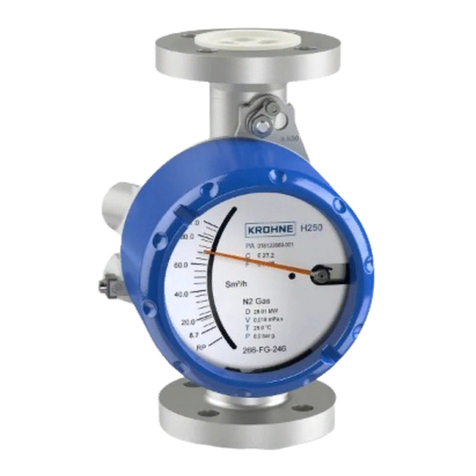
KROHNE
KROHNE H250 M40 ESK4-Basic User manual
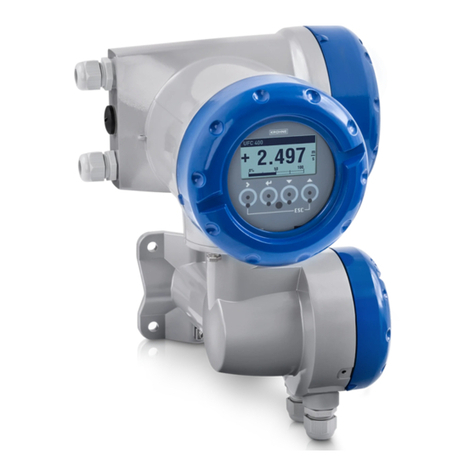
KROHNE
KROHNE UFC 400 Wiring diagram
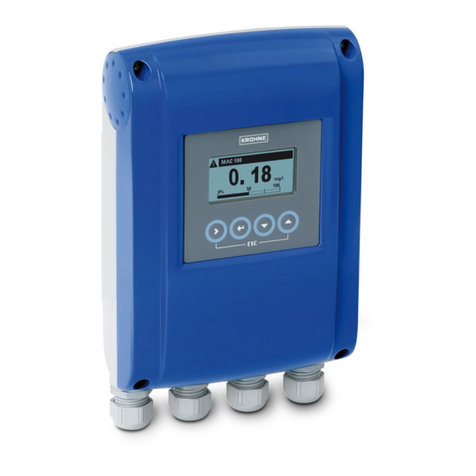
KROHNE
KROHNE MAC 100 User manual
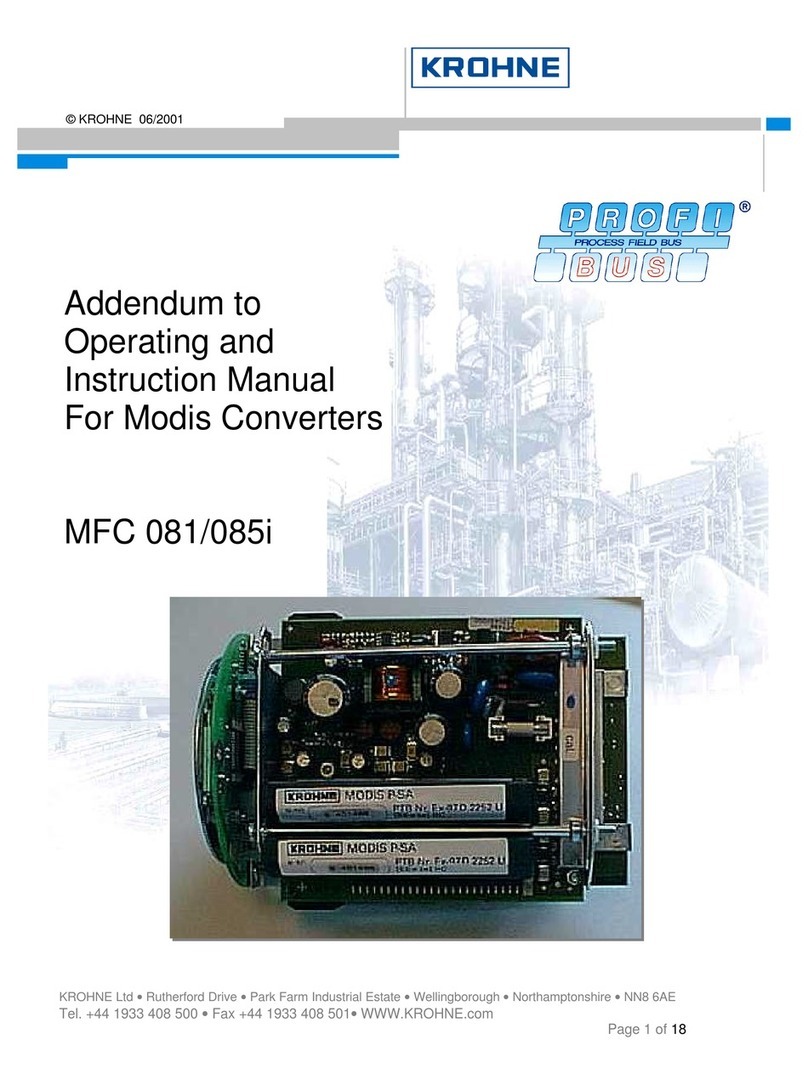
KROHNE
KROHNE MFC 081 Operating instructions

KROHNE
KROHNE ifc 300 User manual

KROHNE
KROHNE UFC 400 Wiring diagram

KROHNE
KROHNE MAC 100 User manual
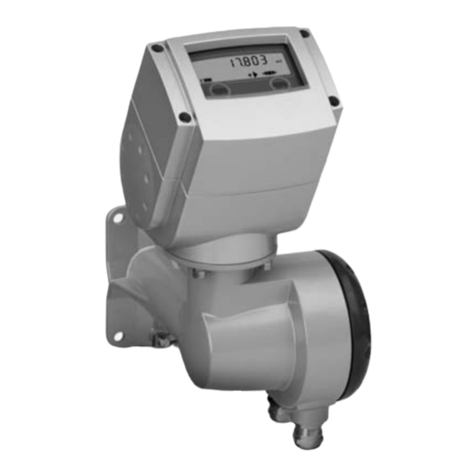
KROHNE
KROHNE IFC 070 User manual
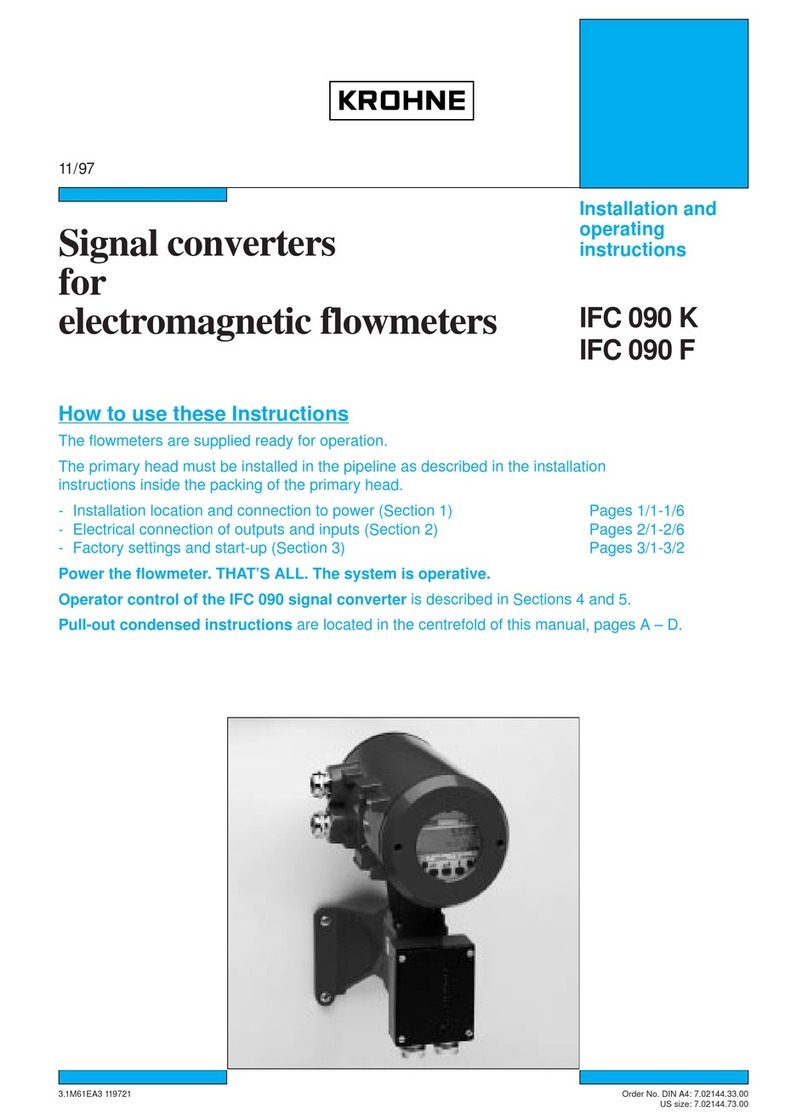
KROHNE
KROHNE IFC 090 K User manual
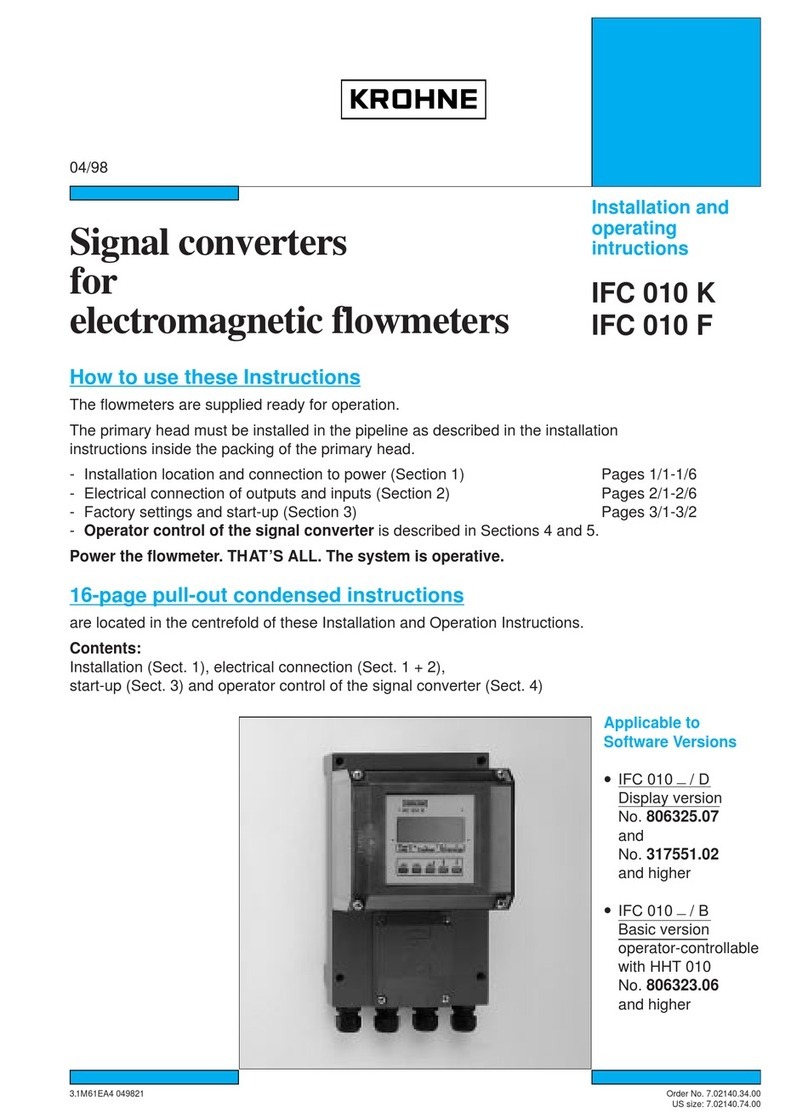
KROHNE
KROHNE IFC 010 K User manual
